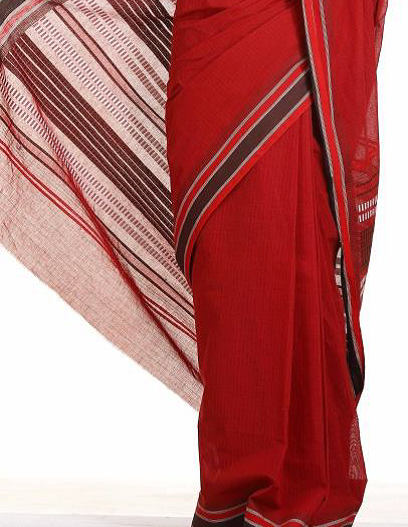Dhaniakhali Cotton Saree
Dhaniakhali Cotton Saree
Back ground
Dhaniakhali Saree is named after the place Dhaniakhali in Hooghly District, West Bengal. It is located at about 50 kms away from Kolkata. In earlier days the ground of the saree used to be in ‘Kora’ or natural grey with either red or black colour plain border. By taking the concept of decorative border design of dhoti the use of 6 levers’ kat-kal’ or barrel dobby came in practice for saree weaving during early 1940 . Dyed yarn was first introduced in 1942. Now a days, lattice dobby is used for weaving bigger designs. Dhaniakhali sarees are produced in Haripal, Rajbalhat Rasidpur, Dwarhata, Ramnagar, Gurap and Antpur area of Hooghly Disitrict in West Bengal.

Materials used
Normally, cotton yarns of 80s to 100scount are used both in warp and weft with extra warp of 2/100s or 2/80s cotton yarn. For 100s cotton warp, reed of 80s is commonly used to keep the traditional texture of the sarees. ‘Sar’ reed is very common in Dhaniakhali and it is manufactured locally from Sar plant (A plant of Bamboo variety). The advantage of using sar reed lies in flexibility and its ethnic look of the fabric.
Weaving technique
Dhaniakhali sarees are woven not in very close texture but with contrasting borders in red, black, purple, orange etc., emphasized by a serrated edge motif. In times, the border was broadened to 6 inches and more and adorned with a variety of stripes in tassar, muga or zari etc. (presently dyed cotton yarn is used). These broad borders known as ‘maatha paar’ or ‘Beluaari paar’ were often in two colours- such as black and red with a compact weave thus making it very strong.
Hank yarn sizing is in practice in Dhaniakhali. The starch used for sizing are mainly sago, arrowroot, rice, wheat, puffed paddy ( Khoi) etc. Sectional warping machine is used to for warping replacing age old street warping. Local wooden lattice dobby of capacity up to 60 levers and 100 for lattice is normally used on pit loom for weaving Dhaniakhali Saree.
How to distinguish genuine Tangail Saree
- Dhaniakhali Saree can easily be distinguished by the presence of ‘khejur chori’ design thread, an arrangement of special weft threads of twisted cotton yarns in two colours woven in palloo portion.
- In this saree picks per inch is always more than ends per inch.
- Grouping of two warp threads in the saree is noticed since bamboo reed is used.
Source : Indian Handloom Brand
Last Modified : 9/5/2023
This topic provides information about Arni Silk Sa...
This topic provides information about Pochhampally...
This topic provides information about Tweed.
This topic provides information about Tussar Gichh...
